CONTENTS:

Visitor Count To Date
Follow the links! This site has more than 32,527 pages with 32,527 individuals and 10,678 families and over 1950 images.
Click here for our Genealogy Names Index.
Welcome to our site.
Please checkout our Patriarchs of Hotchkiss Lines and our updated Grave Gallery features.
|
|||
| site search by freefind |
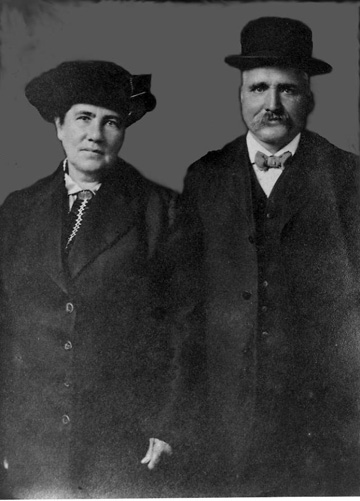
Cornelius Hotchkiss (10 Mar 1858 - 31 Mar 1930, right) and Christina Hotchkiss nee Ferguson (23 Feb 1855 - 23 Aug 1931, left) were married 31 Dec 1878, Bothkennar Parish, Carronshore, Scotland, and immigrated to the United States in 1880, eventually settling in Burlingame, Kansas, along with most of his parent's, Edward and Margaret's, descendants. Cornelius (my gg-grandfater) owned one of the large coal mines in Burlingame at that time.
______

Washington Coal Mine 1913, Burlingame, Kansas. The family of Edward Hotchkiss and Margaret Hotchkiss nee Ferguson came from Carronshore, Scotland to Burlingame, Kansas in order to start mines to supply Kansas City with coal. There they joined others, including the Washingtons, who are also documented on this site. My great-grandfather, James Washington, is among those in this picture. These men, their faces still covered in coal dust, appear to be on lunch break.
______
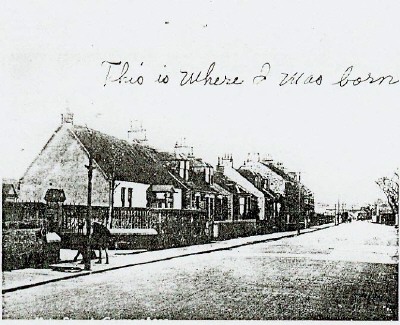
Carronshore home of Edward Hotchkiss & Margaret Hotchkiss nee Penman. The writing is that of Mary Washington nee Hotchkiss. Mary and very likely most of the other nine children of this family, including my gg-grandfather Cornelius, were born in this house.
______
Origin of the Hotchkiss Name
The Hotchkiss name appears to have originated in Shropshire, England during the Norman times. My line of the Hotchkiss family appears to have arrived in the area near Carronshore in the mid-1700's, as the earliest Scottish Hotchkiss in our line, Cornelius (23 Apr 1739 - 28 Apr 1789), was born in Madeley, Shropshire, England, and died in Airth Parish, Stirlingshire, Scotland, where he had been a coal miner. One theory is that he and his family came to Scotland to help improve the mining methods there, after the British conquest in 1746. On arriving in Airth, the local priest apparently had not previously heard the name, and wrote it as he thought he heard it, as "Hodgecase". Remember that most people didn't write at this time, and the priests kept most of the records. This spelling seems to have only lasted about as long as that priest, before it reverted to the more normal spelling of "Hotchkiss". This phenomenon has resulted in many different spellings for the name which are pronounced about the same.
I have recently discovered that Hopkis appears to be a variant of Hotchkiss, where at least initially people would misread the old text "tch", where the first two letters were scrunched together, and the "h" comes down in a tail as a "p." It may have been that some local accents also preferred to replace the sound with a "p". Some earlier records, within about 5 miles of Hawkeswood or Hotchkiswood actually refer to Hopkis of Hopkiswood. All of these records are now included in the tree, where they fit nicely.
There is one name, written as either Hoskins or Hoskis, which appears to actually be the same name as Hotchkiss, but pronounced differently under some of the old accents in London and elsewhere. This has lead to some confusion. It was so prominent in fact that I was able to go back and work all the early occurrences, through 1570 so far, of Hoskins into the Hotchkiss tree. These are definitely the same name. I have fit in the earier knightly records and found well to do Hotchkisses who seem to have retired to the south coast and registered their wills there, for instance Sir Thomas Hotchkiss abt 1460 - 1554 my own 15great grandfather. While I looked in various places to see if there is any early genealogy published by the Hoskins line. So far I found two things: 1. A writeup describing Hoskins history, which refers to a relationship to Wales, which we know exists in that the Hotchkiss family was involved in the Marcher castles on the Welsh boarder and in the relationship to ap_Engion or Benyon, a royal Welsh line with the following Hotchkiss marriages: John Hotchkiss 1607 of the Whitchurch line, Katherina Hotchkiss 1577, John Hotchkiss of Tussingham 1590, and Samuel Hotchkiss Gent. 1652 of the whitchurch line. and 2. There is a discovery person page in the Morman site, www.familysearch.com and some work on www.wikitree.com. This seems interesting except many of the source records and dates are very vague. The main source seems to be a chart from a visitation of 1683 for Hoskyns of Harwood. I have found the initial people from this chart on my tree, although the dates are quite different. As I have included all of the hoskins records I can find up until 1570, and related them to the Hotchkiss family, I would like any Hoskins researchers to view these records, and perhaps let me know about any additional early records.
So far in my research I have found very little need to look at some of the very closely related English names, such as Hodgkins, Hawkins, Hopkins, and Hodges. These may have had a common origin, but appear to have remained separate, for the most part, since early times. I've found a few examples, which appear to have been mis-recorded, such as where only one normally appears in a parish, but then the other appears once, with the same names which are otherwise reported as Hotchkiss. Sometimes, on finding the actual image, the writing was such that it was hard do tell the difference, and the original transcriber appears to have got it wrong.
This is interesting when you realize that the name Hotchkiss itself appears to have originated sometime after 1066 with Anglo-Saxons mispronouncing the French/Norman version of the Name Rodgers. To English ears the French "R" sounds almost more like an "H" than an "R", and is sometimes written as Hr. In French, the "er" at the end of a word is pronounced something like an accented long "a" sound in English. Also, in French, final consonants, such as the "s" would not be pronounced. However, the "s" on the end of a Norman name couldn't be lost as it had a meaning of either "son of", or "belonging to". Perhaps that might have been the reason for the double "s", or which in early versions was often written as the ancient long S character.
The name Rodgers itself originated from those who fought with a rod. In early times, when men were called to war, their society came with them. Their officers were the same lords and knights who ruled them in peace time, and when the lords were called to bring their men, they brought all their men who could carry a weapon, from young teens to old men. If a battle were lost, the village could be without men. When the men were called, they brought their own weapons. It they had armor or a shield, or a horse, they brought them. If they had no weapon, they were told to go into the forest and cut a rod to make a weapon, such as a spear, pike, staff, or bow and arrow. These were the rodgers. In addition, at that time in England, men were also required to practice daily with the longbow.
______
Image of Holdgate Castle from CastleFacts.info, one of the earlier sites where we find one of our ancestors.
A word about the older genealogy records on this site.
I've now included all of the available records that I have going back from 1640's all the way to the 1200's and fit them into the family tree. It should be noted that the records before 1600 are somewhat different than those which came after. Prior to Queen Elizabeth and King James, the church was not required to keep records and often didn't. It did so more often for the gentry. When it did, they were not as helpful. For example, there are many baptismal records with only the child's name. If the parents were recorded, they might include only the father. Even a marriage record might include only the husband's name. Thus putting them together is much more like putting together a jigsaw puzzel and much less a sure thing. None the less I have gone under the assumption that most people managed to get recorded at least once in their life, and used all of the clues available, such as proximity to put them together into a family tree. When you get into the 1400's and earlier, you leave parish records behind altogether, and have only various legal documents, such as deeds to look at, which allows you only to look at what is presented and guess at the rest. When we get to this time, we sometimes have a parent-child relationship and other times, the best we can do is to just have a person representing that generation. I find that putting all the records together makes them much more accurate and useful, than looking at them separately, as you quickly find that if you put them together wrong, the next record will often force you to move the incorrect one to a better place. Thus I have managed to put all the records prior to 1640 together and for the first time united them all into a single tree. They all fit and go back to around 1280. Please take this with a grain of salt. There may be records missing which could change things around. I'm sure as I make more passes through the records, I will find those which have been misplaced. Two John's may have their death dates or even their wives mixed up. Certainly, those children baptized without their parents listed may be with the wrong parent, even though I've tried to pick those parents shown to be living in the correct location and having children at the correct time. It is a bit of a fantasy, complete with knights, and clergy, and other gentry. There is even a great mystery involving Richard III. Enjoy.
______
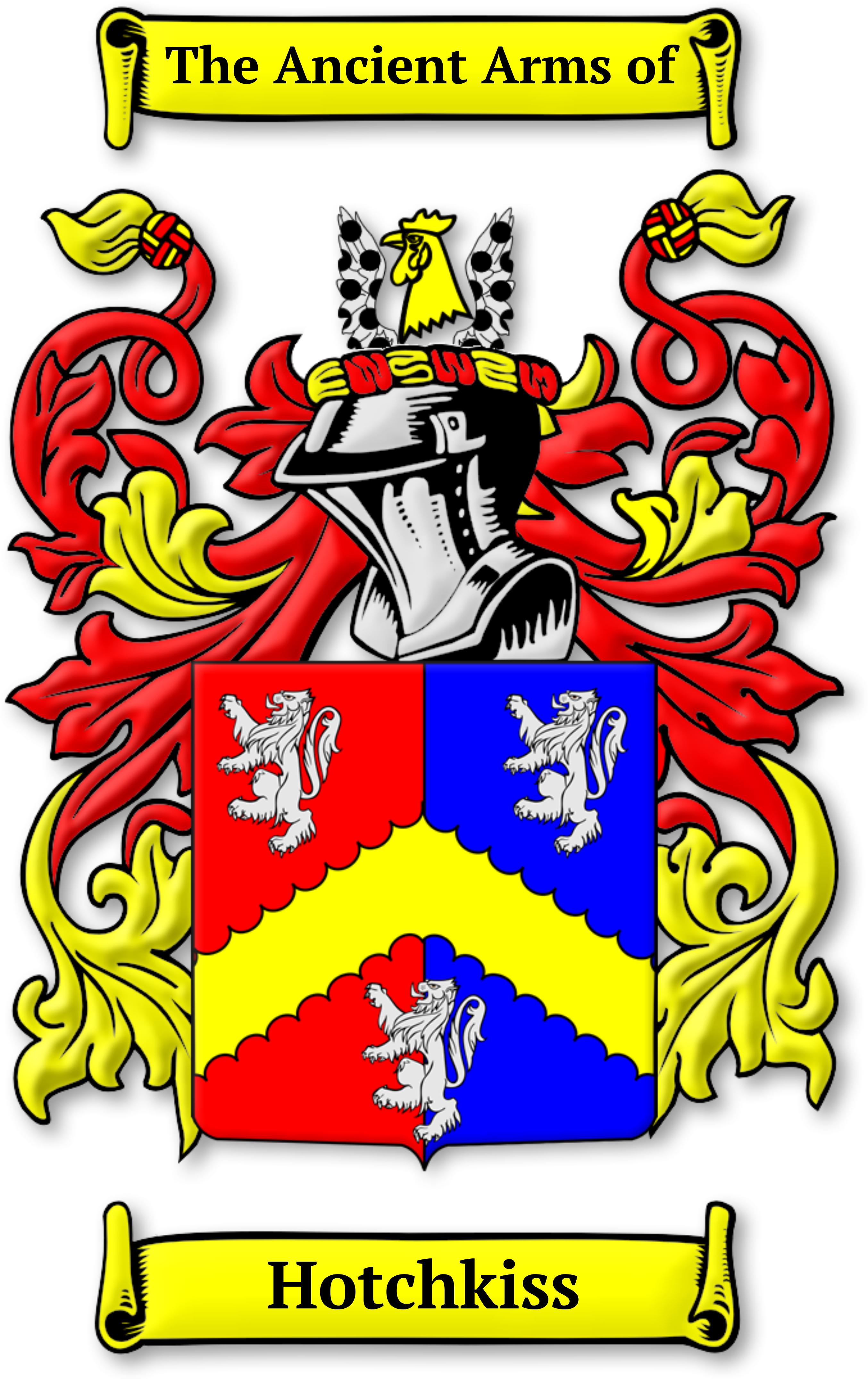
Mystery of the Hotchkiss Arms
The Arms of Hotchkis are given as—"Party per pale gules and azure, a chevron engrailed or between three lions rampant argent." The Crest is "a cock's head erases or between two wings displ. pellettee." These were not allowed in 1663, being said to be, in fact, the Arms of Hoskins.
I've now traced Hochkyswood Manor back to Roger Hochkys, father of John Hochkys in a document dated 1328. Note that at the time, especially prior to 1600, "y" was often used in place of "i" especially for the last "i" in a name, even though there were no real spelling rules and certainly no standard spellings for names.
We go through several generations, some of whom were residents of castles and participating in keeping the peace in the Marches. Some were recorded giving away tracts of land. Please note that the Barons, who were the Marcher Lords had the power and duty to dub knights, and I doubt the records for all of these exist.
Eventually we get to John Hotchkiss of Pulverbatch (abt. 1440 to after 1506). This John lived during the reign of Richard III. This John's wife Margaret was daughter and heir of Thomas Heynes of Wyldyrley, and is recorded giving land in Castle Pulverbatch to one of her sons in 1506. In 1515 John received a pardon from the King. Could this have been for fighting on the losing side under Richard III? Please note that the supposedly complete listing of Knights of England makes a reference to Richard III knighting many more gentlemen without naming them.
John Hotchkiss of Pulverbatch had a son Roger (b. abt 1480). Roger had a son John Hotchkiss of Goze Bradeley abt 1512-1557. John Hotchkiss of Goze Bradeley had a son Roger Hotchkiss (abt 1533 - Feb 1573). Roger had a son William Hotchkiss of Hawkeswood abt 1556 to after 1608, apparently born in London as Hodgkins. William Hotchkiss of Hawkeswood (or Hocheswood) was incorrectly said to have married Jane Bromely, widow of Sir George Bromely, knight and chief justice of Chester, and daughter and heir of John Wannerton, esq, of Wannerton. However this was actually the cause of a messup in recording of the line owning Hawkeswood, because what really happened is that the true owners of Hawkeswood rented out the manor while spending most of their time in London after John Hotchkiss of Pulverbatch was knighted and the succession of both the knighthood and the manor followed the same people. Thus Jane Bromely became acting lady of the manor of Hocheswood by rental. It appears the wife of William Hotchkiss was in fact Jane Northwood of Northwood, a neighboring manor, as Norman/English gentry seemed to like to use the names of their estates for surnames. William Hotchkiss's son Richard (abt 1595-1645) was also born in London as Hodskyns. It seems that people in London were recording the name as Hoskyns or some varient, as Hotchkiss to this point was mostly used in the Marches of Shropshire. I've documented several cases of Shropshire Hotchkiss sons in London, doing things like going to Oxford, and recorded as some spelling of Hoskyns. Richard had a son George (b.abt 1625). George was present for the 1663 visitation of Shropshire and most likely presented the Hotchkiss pedigree chart found there.
The Hotchkiss arms were also presented in the 1663 visitation and rejected as belonging to Hoskins. This didn't actually make them invalid as it turns out that they actually presented the newer arms of the great-great grandson of the original knight. The presentation stated that they were from a Hotchkiss knight dubbed by King Richard III, and came down by the standard rules along with the manor. So far I've only found one Hotchkiss, John Hotchkiss of Pulverbatch, recorded as being alive during Richard III (reign Jul 1483 to Aug 1485), although I've also now found two brothers who could have been as well. Now it should be noted that arms are passed down father to son, and there is only one son who is entitled to the arms under hereditary rules. However, if other relatives are also knighted, their arms are usually created from those of their ancestor knight but with some minor change, such as to the crest in this case.
______

The Hoskins Arms
The Arms of Hoskins (Oxted, co.Surrey) are given as—"Per pale gules and azure, a chevron engrailed or between three lions rampant argent." The Crest is "a cock's head erased or, pellettee, combed and wattled gules between two wings expanded of the first.
The earliest Hoskyns with similar arms was knighted in 1605 at Windsor Castle and was Sir Thomas Hoskins of Oxted, Surrey, which is just south of London. The only reasonable christening I could find for him was 11 September 1562 in London, which does not show parents. Sir Thomas had 8 children with Dorothy Aldersey from 1602 to 1618. The only difference between his arms and the Hotchkiss arms is a slight change to the crest, where the cock's head and wings are treated differently. Sir Thomas's pedigree was recorded in the 1623 visitation of Surrey. Sir Thomas apparently died in 1615 and the pedigree was given by two nieces. They gave his parents and grandparents, but the grandparents were very vague. Also an "Inhabitants Of London & Family Units" Census/Survey was filled out by his father in 1550 and seems to have somehow gotten all the information included up until 1601. I started with the earliest available Hoskins records, and eventually worked them into the Hotchkiss tree. This provided the actual records for his family and shows that he is in fact the great-great granson of the earlier Hotchkiss knight.
______
.png)
The Hodgkis of Amphil Shield
The Arms of Hodgkis of Amphil are reported in the Visitation of Bedfordshire as-"Sable, a chevron or between three giffin's heads erased aregent." The crest is recorded as "A cubit arm erect in a coat of mail argent, garnished or, holding in the hand proper a griffin's head erased of the second, beaked azure." I couldn't find this image for sell, so I used a tool to create the shield, but could not find one for the crest.
The earliest Hotchkiss given in the visitation was Sir William Hodgkis of Petton This line is also known as Hotchkiss of Whitchurch and is the line which leads to the early US imigrant to New Haven, Connecticut, Samuel Hotchkiss from which so many in the United States are decended. I'm not sure who the original knight for this line was and would like to find that history. However, it also appears to go back to the same original Hotchkiss knight as perhaps his grandson.
______
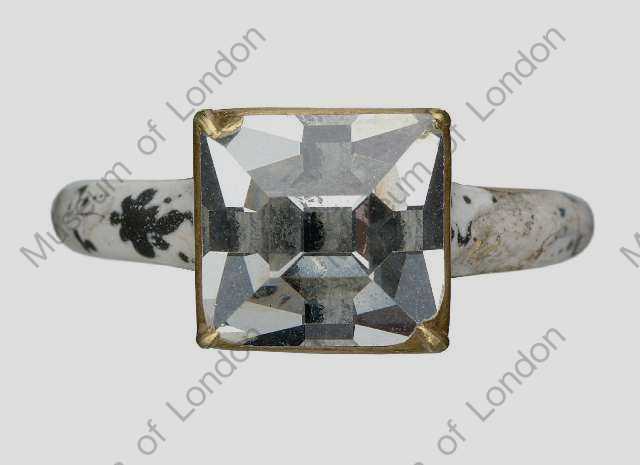
Example Museum of London image of a different but possibly similar diamond ring dated 1501 AD - 1625 AD from the "Cheapside London Hoard"".
Mystery of the Lord Mayor's Ring
There is also a story from the will of Margaret Hart Hotchkiss dated 3 Apr 1875, later in this same line, of a ring given by Richard I to a relative of the family (not necessarily a Hotchkiss and it could have been from the Harts) who was Lord Mayor of London, and was also being passed down the male line of the family. As there was only one Lord Mayor during Richard I, this would have been Henry FitzAilwin, who was not Norman, despite the name. However, if she actually meant Richard III, there would have been a bit more choice including Sir Thomas Hill, who was said to have dined with the King, and who’s father appears to be from Hodnet, Shropshire and his mother from Malpas, Cheshire, both of which are near locations which relate to the Hotchkiss family. It should be noted that Lord Mayors are also commonly knighted.
______
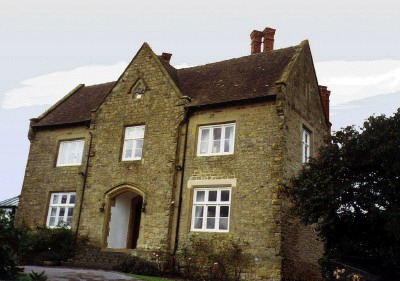
Hochkyswood or Hokeswode or Hawkeswood - near Sidbury (sometimes called Sudbury), in Shropshire, England (This picture from Stuart Hotchkiss, VP of the Hotchkiss Family Association). The oldest Hotchkiss record found so far concerns this manor which belonged to what may be our oldest known common ancestor, Roger Hochkys. This story reminds me of Miss Havisham in Charles Dickens's Great Expectations. Hochkyswood was once the manor house of another Hotchkiss line, besides my own, which came to Scotland in the mid-1700's. James Hotchkiss of Hawkeswood, and of Sudbury apparently sold the estate and moved to Edinburgh, where in 1751, he married Elizabeth Cleghorn, the daughter of a wealthy brewer. There the "Roll of Edinburgh Burgesses and Guild Brethren, 1761-1841" from the Scottish Record Society, shows that on 27 June 1769, he was a merchant and brewer, a burgess of Edinburgh and Gild Brother in or by right of his wife Elizabeth, daughter of Thomas Cleghorn, merchant, burgess of Edinburgh and Guild Brother. James Hotchkiss' sons John and Thomas also carried on this profession. I have found that many in James' line eventually found their name transformed to "Huskie", as it seems that in Scotland Hotchkiss is often pronounced more like "Hotchkie", dropping the final consonant sound, similar to the way the French do. There was a family diamond ring in this line said to be given by King Richard the 1st to one of the Family who was "Lord Mair" of London. This was last recorded as given in the will of Margaret Hotchkiss nee Hart, the wife of James Hotchkiss, Esq. to their son Dr. Richard James Hotchkiss in 1876 "to go down in straight male line".
The oldest records from our forebear Roger Hotchkiss of Hawkeswood, first of the surname Hotchkiss and his ancestors, the de Northwoods, listed the name of the Hawkeswood manor as Hokeswod (1280) and Hoxwode (1310). Roger's name is the first given as Hochkys, which seems very similar to Hokes of Hokeswod. His father Hugh le Mou de Hokswod and his grandfather John fitz Nicholas de Northwod et de Hoxwode both were referred to as "de Hoxwode" at least some of the time, but his great-grandfather Nicholas de Northwod always appeared as "de Northwod".
Our name has layers of meaning. Our early Norman ancestors were both very religious and were soldiers of the March, perhaps actually rogers, with spears or rods for weapons. Hoxwode though may have some special significance. In the Church Latin, in which pretty much all records of the time were written, the letter X has a special significance, although Latin did also use X as a letter sounding like 'ks', X was the shorthand for "Christ". Latin was full of abbreviations and contractions, which becomes very obvious when trying to read these Latin records. It was used in place of the sound of "Christ", wherever it might occur in a word. For example, Christopher Latinized was Xpoferi. Thus Hoxwode could actually be speculated to mean Hochristwode. It is possible that this may have meant something like Holy Christ Wood or maybe expanded in the manor of the current Roman Catholic Church to Holy Cross Wood. Thus early church writings regarding Christmas, for instance, would have and did actually use the word Xmas. Our ancestors and all the soldiers of the March kept these values and this landed them on the side of the old ways, which happened to be the losing side, in both internal wars. In the War of the Roses, we find our ancestor knighted by Richard III, a direct Norman descendant, with the succeeding Tutors being not nearly so related to the Normans. During the English Civil War, Shropshire, in general favored the Royalists and a number of the March Castles were destroyed or damaged in fighting.
______
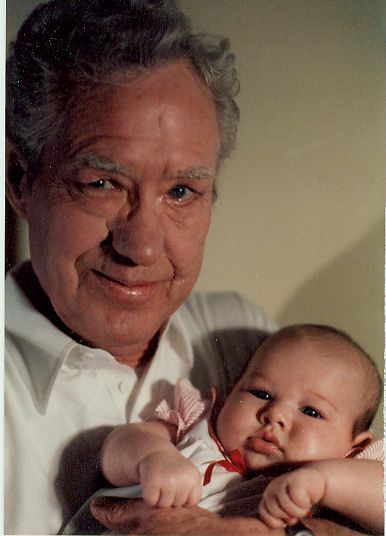
James Arthur Hotchkiss(6 Dec 1914 - 14 Jan 1991) and great-granddaughter in 1986. My grandfather, known as Jimmy, had genealogy as a hobby. I used to help him with this when I was young, and promised to continue his work when he was gone.
ADS:
vvvvvvvvvvvvv